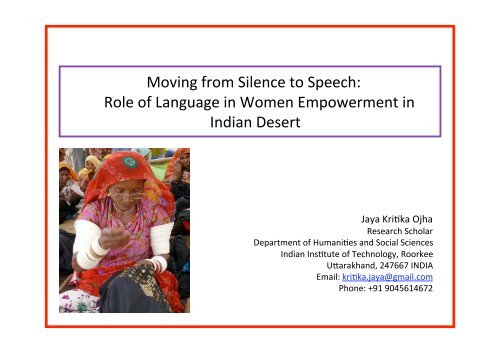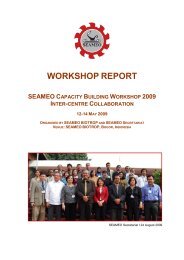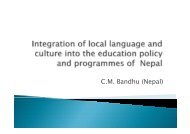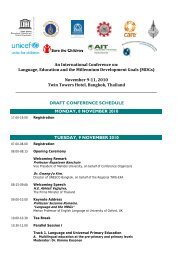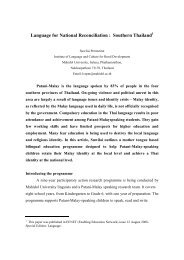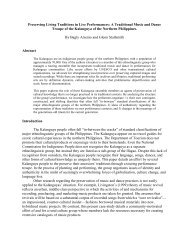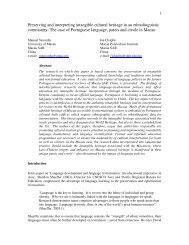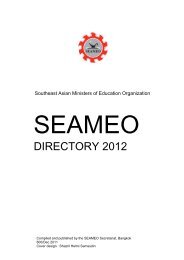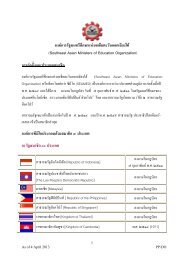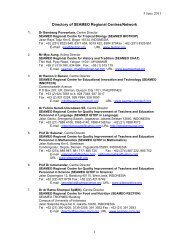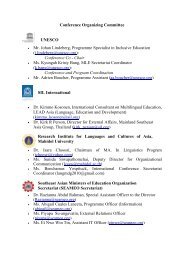Jaya Kritika Ojha_Silence to Speech presentation
Jaya Kritika Ojha_Silence to Speech presentation
Jaya Kritika Ojha_Silence to Speech presentation
Create successful ePaper yourself
Turn your PDF publications into a flip-book with our unique Google optimized e-Paper software.
Moving from <strong>Silence</strong> <strong>to</strong> <strong>Speech</strong>:<br />
Role of Language in Women Empowerment in<br />
Indian Desert<br />
<strong>Jaya</strong> KriAka <strong>Ojha</strong><br />
Research Scholar<br />
Department of HumaniAes and Social Sciences<br />
Indian InsAtute of Technology, Roorkee<br />
UIarakhand, 247667 INDIA<br />
Email: kriAka.jaya@gmail.com<br />
Phone: +91 9045614672
The role of language and communicaAon skills in women<br />
empowerment and building their capaciAes<br />
Language and communication skills are strategic and powerful <strong>to</strong>ols<br />
that can<br />
• Improve the chances of success of socio-economic development<br />
• Make behaviour and attitudinal changes<br />
• Information dissemination, education, generate awareness
Women‐ An Equal Partner of Society<br />
• The 2001 census suggests women as an independent group cons:tu:ng 48%<br />
of the country’s <strong>to</strong>tal populaAon<br />
•Women in India remain one of the most disadvantaged groups in society<br />
•Viewed against almost all the indica<strong>to</strong>rs of development, women con:nue <strong>to</strong><br />
lag behind men<br />
Facts about women<br />
•lack choices and opAons<br />
•restricted by poverty<br />
•face illiteracy, poor nutriAon and health care<br />
•lack access <strong>to</strong> reproducAve health<br />
•bear domesAc violence and fear<br />
•limited in their noAons of gender roles<br />
•lack in understanding the reasons behind gender discriminaAon<br />
…all these lead <strong>to</strong> vulnerability<br />
By accep%ng the lower status given <strong>to</strong> them, they also accept the stereotypes that<br />
o1en restrict <strong>to</strong> express themselves and confine <strong>to</strong> a role that s%fles sensi%vity and<br />
crea%vity.
Women in India: The Facts<br />
The <strong>to</strong>tal female populaAon: 496 million (49.6 crores),<br />
consAtutes 48.26 % of the country’s <strong>to</strong>tal populaAon<br />
Of the 496 million (49.6 crores) females,<br />
360.9 million (36.09 crores) live in rural areas<br />
Sex raAo: There are only 933 women,<br />
for every 1000 men in India<br />
Women’s access <strong>to</strong> literacy and educaAon: 53.7 percent of women<br />
are literate against 75.3 percent for men, shows a gap of 21.6 percent<br />
School enrolment exhibits gender dispariAes<br />
21.6 percent gender gap in school enrolments<br />
Employment record of women shows more women in<br />
unorganized sec<strong>to</strong>r and in unskilled and lesser‐paid jobs<br />
Data source: MWCD Report, 2007, Census 2001 of India
• Women need <strong>to</strong> understand the power of knowledge and information.<br />
• Strategic involvement of women’s own knowledge and skills in the<br />
whole process.<br />
•emergent need is <strong>to</strong> promote education, training and professional<br />
development for women<br />
• Effective and fluent language-communication skills are important <strong>to</strong><br />
build the capacities of women <strong>to</strong> make them realise and use their<br />
strength, potentials, and capabilities.<br />
•Communication can contribute significantly <strong>to</strong> enhance capacities of<br />
women, <strong>to</strong> make them aware of their privileges and rights, their calibre<br />
and potentials.
The<br />
Thar<br />
Desert
The Thar Desert<br />
The Thar desert region is a challenging<br />
area <strong>to</strong> live and survive.<br />
•Harsh, <strong>to</strong>ugh, receives less than 160 mm<br />
rainfall annually, perhaps the driest<br />
region of the country.<br />
•Vast, arid and unfriendly terrain with shifting sand dunes,<br />
sparse population, extreme temperatures, stunted<br />
vegetation and very little arable land.<br />
•People of Desert struggle <strong>to</strong> earn their bread, as the<br />
livelihoods options are very few in the region.
RaAonale/Significance of the paper<br />
Thar Desert region has a high populaAon of women engaged in<br />
non‐farm acAviAes for income generaAon.<br />
They are skilled, they embroider beauAfully, and they know their<br />
tradiAonal craf very well.<br />
They colour, design, create and produce beauAful hand<br />
embroidered garments and apparels.<br />
This is their only earning source for food, fodder and fuel.
• Have no power, no control in decision making process, no<br />
access <strong>to</strong> resources, no parAcipaAon<br />
• Unequal status leads <strong>to</strong> their subordinaAon<br />
• Do not understand the dynamics of the market<br />
• Not aware enough <strong>to</strong> understand the buyer’s expectaAons for<br />
a product<br />
• Not vocal enough <strong>to</strong> ask the buyer about their expectaAons,<br />
requirements, needs and demands
Women ArAsans and the Requirements<br />
Need <strong>to</strong> learn buyer’s language, buyer’s cultural needs, buyer’s behaviour<br />
according <strong>to</strong> the income and demands<br />
Need <strong>to</strong> understand that expected quality work can provide more money and<br />
beMer opportuni:es <strong>to</strong> ensure be9er life of their families and children<br />
Need <strong>to</strong> upgrade their innate quali:es<br />
Learn <strong>to</strong> nego:ate, <strong>to</strong> make decisions ‐<strong>to</strong> lead the process of empowerment<br />
Learn <strong>to</strong> enhance their outreach through words and<br />
language <strong>to</strong> prospec=ve buyers ‐those who have power,<br />
money, and opportunity<br />
Need <strong>to</strong> learn technical language,<br />
require training <strong>to</strong> polish their<br />
handicraO skills
Objectives of the paper:<br />
1.To understand the role of language and communicaAon in<br />
women empowerment, livelihood generaAon and socioeconomic<br />
development in India<br />
2.To develop and analyse case studies of five women arAsans<br />
of desert region who learned improved communicaAon skills<br />
<strong>to</strong> enhance their livelihood.<br />
3. To emphasize the importance and role of language and<br />
communicaAon skills as a process of empowerment for<br />
women arAsans.
The method<br />
1.QualitaAve analysis methods leading <strong>to</strong> develop five case studies.<br />
2.The study used both primary and secondary data.<br />
3.The <strong>to</strong>ols adopted for the paper were personal interviews, observaAons,<br />
and area survey.<br />
For collec:on of primary data<br />
•Focused interview schedule<br />
•Five Case studies<br />
For Secondary data<br />
• Books, arAcles, journals, research papers, official documents and<br />
insAtuAonal websites..
Village :<br />
Age:<br />
Leader:<br />
Monthly income:<br />
2DO<br />
35 years<br />
2 SHGs<br />
3500‐4000 INR<br />
Case I: Samu Bai<br />
Working from the age of 10. Learnt the skill from her paternal Aunt. At 14 she was an expert in<br />
embroidery under the apprenAceship of her aunt.<br />
AOer par:cipa:ng in communica:on trainings by URMUL‐ she developed<br />
1.interested in reading news papers<br />
2.s<strong>to</strong>ry books and<br />
3.watching videos.<br />
Her handwork and knowledge of Hindi and familiarity with English words made her indispensable for<br />
URMUL coordina<strong>to</strong>rs.<br />
The con:nuing process of<br />
•learning language<br />
• gathering informaAon<br />
• complemenAng it with her pracAcal experiences<br />
• accumulaAon of knowledge is self moAvated<br />
She translates and interprets from Thari <strong>to</strong> Hindi and vice‐a‐versa. Self conducted but admired,<br />
accepted and appreciated by others.<br />
She says “Kashida <strong>to</strong> hamare liye khet aur fasal hai”, (For us this embroidery work is like fields, crops<br />
and produce).
Case II: Paaroo Bai<br />
Village:<br />
Team Leader:<br />
Migrated after:<br />
Skill:<br />
Dandkala<br />
2 SHGs<br />
After 1971 Indo –Pak<br />
Kashida Work. The skill of kashida was the only means of survival though they were<br />
exploited from the middlemen from Barmer district.<br />
URMUL unders<strong>to</strong>od the need and responded accordingly by starting income-generating programme of embroidery<br />
along with the technical language-communication training initiative.<br />
Paaroo Bai motivated and organised other women for the URMUL initiatives through village self help groups. They<br />
were supported by<br />
1. Expert designers like Laila Tayabji<br />
2.Graduates from National Institute of Design (NID)<br />
3.Other prestigious organisations in India<br />
Paaroo Bai completed all her capacity building trainings and soon she organised her fellow workers in village<br />
regarding:<br />
•Health<br />
•Plantation<br />
•Child-care<br />
•Raised voice against liquor consumption by men, and other evil practices.<br />
This was the result of their ongoing process of technical language exposure which made them confident and vocal,<br />
<strong>to</strong> raise their voices against every odd.<br />
Paaroo Bai says “Hamara gaun aage badh raha hai” (Our village is moving ahead).
Village: Aduri<br />
Monthly Income: 3000 INR- 4000 INR (80-100 USD)<br />
Case III: Ramku Bai<br />
Heard about the progress of Dandkala village and went <strong>to</strong> meet URMUL officials <strong>to</strong> start income generating activities in<br />
their village <strong>to</strong>o. Showed their own skills <strong>to</strong> URMUL officials, convinced them and became a working group of this income<br />
generating venture.<br />
Ramku and her group members joined the Technical language trainings and after continuous trainings and regular<br />
exposures with the experts, these women have become efficient producers and sellers.<br />
Ramku Bai says that the involvement in kashida work helps them-<br />
In not migrating <strong>to</strong> cities<br />
They work from their homes<br />
They earn with Dignity<br />
Comfortable amongst their group speaking in their own language Thari, and expressing their views freely<br />
The new found confidence is because of their-<br />
1.Exposure <strong>to</strong> the outer world<br />
2.Capacity building trainings<br />
3. Learning new words of the language of city people<br />
4.Interaction with URMUL officials, designers and buyers<br />
The journey with URMUL has transformed the lives of all the women of the Village Aduri.<br />
•Some of their songs have become very popular and have been multiplied in the forms of CDs and audio-cassettes.<br />
•Video films about their work and life have been made by various film makers<br />
•Now there is a school in the village which they demanded for their children<br />
•A water course<br />
•Men-folk of their village don’t sit idle now<br />
• Listen <strong>to</strong> the women’s voices and accept their important roles as bread-earners
Village :<br />
Age :<br />
Skill:<br />
Monthly Income :<br />
Migrated from :<br />
7AD<br />
20 years<br />
Sample design<br />
INR 3500 approximately<br />
Chachro (Pakistan)<br />
Case IV: Kely<br />
Then<br />
• Kely and her 8 years old younger brother used <strong>to</strong> work in the fields with other relatives.<br />
• They earned 10 INR each for the hard work of collecting peanuts or cot<strong>to</strong>n from the fields.<br />
• After a year she began working along with her mother as a hand-embroiderer.<br />
• Got 20 INR for one Khalichi (Hand Purse)<br />
• Embroidered one Kurta in 2 days for 30 INR (.70 USD)<br />
She volunteered and eagerly participated in different trainings on improving communication skills, gender issues and better<br />
marketing conducted by URMUL.<br />
These trainings enhanced her<br />
1. capacities<br />
2.gave her a better view and wider perspective of her own self, family and community.<br />
Now<br />
• Kely now creates new designs, matches colours and develops patterns.<br />
• keeps her earnings in her saving account in a bank.<br />
• saves more money and supports her mother.<br />
• she can embroider three kurta's in a day. Every piece she embroiders is a complete artwork in itself.<br />
• Her embroidery work goes <strong>to</strong> foreign countries.<br />
• She is not educated but confidently uses words like sampling, courier, cash, design, payment, colour matching, bank, saving,<br />
road, city, cooler etc. with ease<br />
Kely is very particular about the education of her younger brothers and sisters and wants them <strong>to</strong> get higher education.<br />
She dreams about a bright future of her family.
Case V: Babri Bai<br />
Village:<br />
Migrated from:<br />
Skill:<br />
2D0<br />
Pakistan (after 1971 Indo-Pak war)<br />
Embroidery (never thought it as a livelihood option)<br />
Registered herself in URMUL’s interventions of livelihood and attended the technical language learning<br />
programmes related <strong>to</strong> her work.<br />
In her village she gives lessons <strong>to</strong> her group members as a peer leader and has become an efficient team<br />
leader. She is very vocal now and confidently inquires about her entitlements.<br />
Responsibility: Checks the quality of each embroidered piece.<br />
Quality: Punctual about completing the work in time and getting the payments of her group.<br />
Dream: Every girl child should attend school and after that attend training sessions of embroidery and become<br />
entrepreneur.<br />
Social Activities:<br />
•Ensures complete immunization of every child<br />
•proper care of older people of the village<br />
•Visits each household and inspects the cleanliness and hygiene<br />
Present dynamics of her village<br />
• Women no longer wear veils (ghunghat).<br />
• Men of the families have become supportive.<br />
• Many men now work in the kitchen, as their wives are busy in embroidery work and their daughters are studying<br />
in schools.<br />
Babri Bai says the name and flag of the organisation should fly high because of their craftwork.
CONCLUSIONS<br />
Women enhanced their<br />
Modes of expressions<br />
Learnt how <strong>to</strong> communicate effectively<br />
Their technical and communication skills have made them feel<br />
comfortable when they say hello, market, profit, bonus, meeting, training, workshop, cash, bill,<br />
payment, designer, courier, exhibition, reservation, train, order, complete, flight, road,<br />
recording, camera, mike, meeting, training, workshop, collec<strong>to</strong>r etc.<br />
Expressing and Enjoying their freedom developed their capacity of leadership, negotiation,<br />
participation and decision making.<br />
Status of these women artisans has increased :<br />
due <strong>to</strong> their major contribution in increasing the incomes of family<br />
•their exposure of the outer world<br />
•their capacity <strong>to</strong> deal with the buyers with confidence<br />
•regular savings from their income for health, nutrition and early childhood education<br />
•girls are now studying in the village schools with boys which was restricted earlier
CONCLUSIONS<br />
INTERPLAY AND CONVERGENCE OF LANGUAGES<br />
ACCELERATE THE PROCESS OF LEARNING<br />
LANGUAGE ENHACES CAPACITIES LEAD TO EMPOWERMENT<br />
LANGUAGE COMMUNICATION INFORMATION KNOWLEDGE<br />
EMPOWER
RECOMMENDATIONS<br />
On the basis of interaction with the women artisans and observations it is<br />
recommended that<br />
After need-assessment regular follow-up training courses should be devised<br />
for them <strong>to</strong> enhance their communication skills.<br />
(It will develop their innate qualities of leadership, negotiation and decision<br />
making in a better way)<br />
Such trainings would give them confidence <strong>to</strong> raise their voices and break the age<br />
old silence with their speech.<br />
Then they could definitely enter in the ongoing process of empowerment leading<br />
<strong>to</strong> a better future.
THANK YOU


